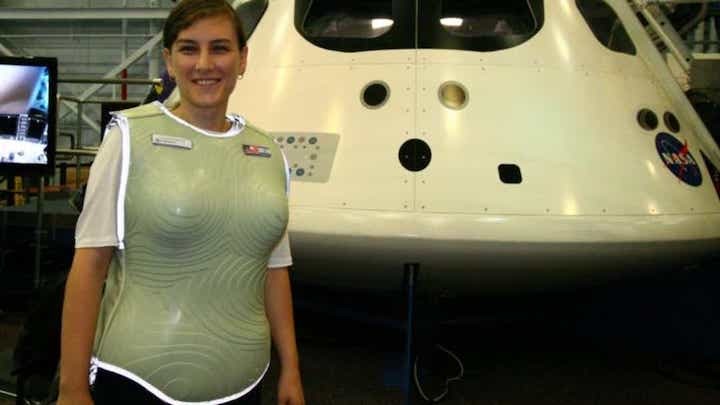17.06.2019

The last time a human stepped on the Moon, the Watergate hearings were well under way, Henry Kissinger and Le Duc Tho were negotiating a peaceful end to the Vietnam War, and people were playing PONG, the world’s first video game.
A partnership between NASA, a Florida-based company and an Israeli company will help make the next manned flight to the moon possible.
Lockheed-Martin and StemRad have been perfecting a wearable radiation shield, or vest, to protect astronauts on deep space flights.
It’s just one of several partnerships emerging from the recent business development mission Gov. Ron DeSantis led in Israel during the last week of May.
While in Israel, DeSantis met with leaders of StemRad, which also picked up a $250,000 grant with Lockheed Martin to help pay for the final development and testing of AstroRad. The vest is being tested on the International Space Station and will be installed on a mannequin on the Orion EM 1 flight around the moon some time next year, the last test flight before NASA begins deep space missions again.
“We have been human factor testing with live astronauts on the International Space Station,” said Gideon Waterman, chief technology officer for StemRad, which manufactures protective gear for first responders and the military, including a 360 gamma rated equipment for Chernobyl-type situations.
The space suits used now are adequate for the low Earth orbit of the space station, but greater protection is needed beyond the Van Allen radiation belts, Waterman said. The AstroRad vest is designed to protect vital organs and soft tissue from the higher radiation bombardment they will be exposed to in deep space by cosmic rays and solar storms.
The Matroshka AstroRad Radiation Experiment will consist of two mannequins supplied by the German Aerospace Center placed on the EM 1, also known as Artemis 1. One will be equipped with the vest and the other will not. Thousands of radiation detectors on the mannequins will measure the effect of radiation on the dummies, and how well the vest shields them.
"The team at StemRad has been working extremely hard to design, tweak and improve AstroRad and we are confident that it will pass the tests presented during the EM-1 mission with flying colors,” Dr. Oren Milstein, Founder and CEO of StemRad, said in a news release.
The grant was awarded during the same week that Space Florida signed two Memorandums of Understanding while in Israel — one with the Israel Space Agency and another with the Israel Innovation Authority. Three other Israeli-American collaborations also received grants.
The MOU with the Israel Space Agency is a new one that contemplates future space projects that could have real earth applications for agricultural and environmental issues.
“I want to thank the leaders from the Israel Space Agency for joining us to offer an opportunity to increase collaborative research, provide educational enrichment for our students and drive innovation like never before,” DeSantis said.
Space Florida CEO Frank DiBello said he was excited to collaborate with the Israel Space Agency.
“As we highlight and seek solutions to bio-agriculture and water issues, the goal is to inspire and encourage students to seek scientific solutions and encouragement from this international partnership,” DiBello said.
DiBello described the agreement as a framework for future collaboration on projects that support space exploration, scientific research and other common interests. Specific areas of collaboration mentioned in the agreement include remote sensing programs and STEM-focused CubeSat competitions for students in Florida and Israel.
“The intent would be to focus on taking space-related research from satellites and the International Space Station (ISS), and applying discoverable science to major agriculture and water issues which have a global impact,” a draft of the MOU said. “The goal would be to obtain high-resolution photos of specific sites to track environmental issues such as desertification, erosion, pollution, natural disasters and other phenomena associated with environmental damage.”
The agreement also contemplates Israel Space Agency launch opportunities from Florida. The agency last used Cape Canaveral to launch its Beresheet lunar module in April. The craft crash-landed after successfully orbiting the moon, but was still celebrated as a victory.
The second memorandum of understanding is a renewal of a 6-year-old agreement in place between Space Florida and the Israel Innovation Authority.
“We are so pleased to expand the scope beyond aerospace to include agriculture, clean water and cyber security,” DiBello said.
Israel Innovation Authority is an independent, publicly funded agency “created to address the needs of the local and international innovation ecosystems.”
In 2013, Florida and Israel established a $2 million recurring joint fund to support research, development and commercialization of aerospace and tech projects to benefit both countries.
SIXTH CALL FOR PROJECTS WINNERS
For six years now Space Florida and the Israel Innovation Authority have put out a call for projects.
This year’s winners, besides StemRad and Lockheed Martin, were:
♦Harris Corp, of Melbourne, and NanoDimension of Israel, to develop 3D printing materials on the International Space Station… for lower-cost manufacture of smaller satellites
♦CadW Therapeutics, Moffitt Cancer Center of Tampa and SpacePharma of Israel … developing a microfluidics Lab-On-A-Chip that analyzes stress and DNA damage and responses during space flight
♦Semplastics of Oviedo and Polymertal of Israel to develop a novel variety of hybrid materials suitable for aviation and space applications ranging from structural parts to electronic assemblies.
Quelle: Florida Today

